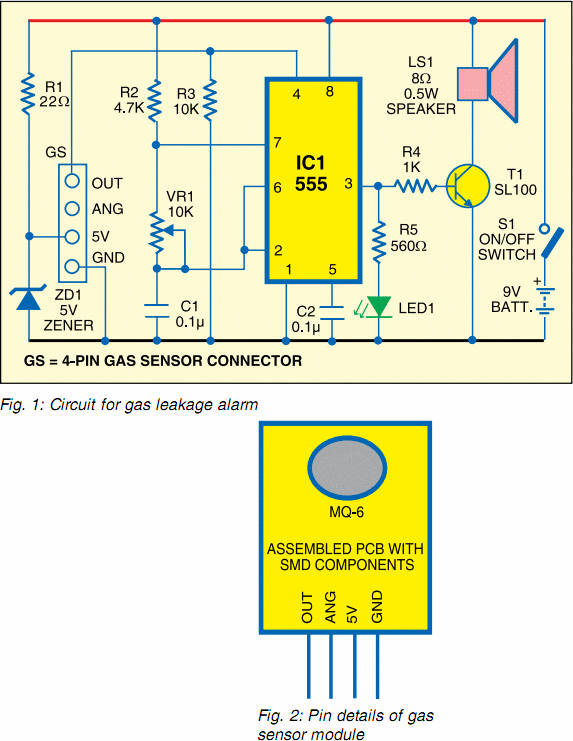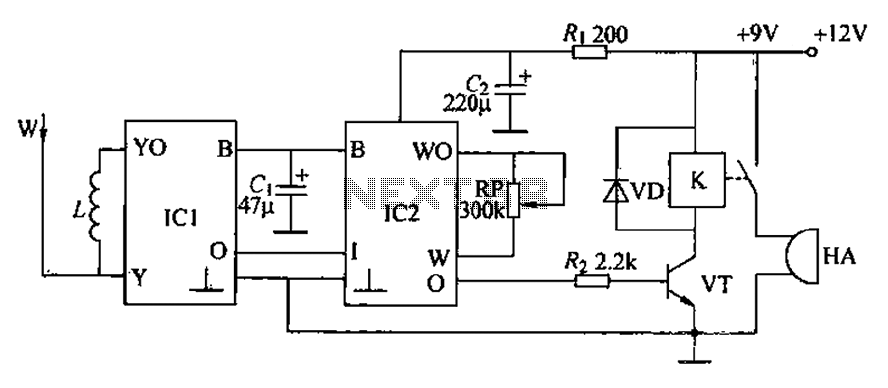
gas leakage alarm

LPG gas is supplied in pressurized steel cylinders. Being heavier than air, it tends to flow along the floor and settle in low spots such as basements when leaked. This poses risks of fire or suffocation if not addressed. A circuit designed to detect LPG gas leakage alerts users through audio-visual signals. The circuit operates on a 9V PP3 battery. A Zener diode (ZD1) converts the 9V supply into 5V DC to power the gas sensor module. The SEN-1327 gas sensor module from RhydoLABZ is employed, which outputs a high signal when gas levels reach or exceed a specified threshold, adjustable via a preset within the module. The sensor module interfaces through a 4-pin SIP header, with pin details provided in accompanying documentation. An MQ-6 gas sensor, known for its high sensitivity to propane, butane, isobutene, LPG, and natural gas, is included in the module. It is also capable of detecting combustible gases, particularly methane. The circuit has been tested with LPG gas and performed satisfactorily. When LPG concentration reaches 1000 ppm (parts per million), the OUT pin of the sensor module activates. This signal triggers a timer IC 555, configured as an astable multivibrator, which functions as a tone generator. The output from pin 3 of the IC 555 connects to an LED (LED1) and a speaker-driver transistor (SL100) via current-limiting resistors (R5 and R4). The LED illuminates, and an alarm sounds to notify the user of a gas leak. The tone's pitch can be adjusted by varying the preset (VR1). A suitable heat sink should be utilized for the transistor SL100.
The LPG gas leakage detection circuit is a crucial safety device designed to monitor the presence of LPG in the environment. The operational foundation of this circuit relies on the sensitivity of the MQ-6 gas sensor, which is adept at detecting a range of combustible gases. The sensor’s output is directly linked to the timer IC 555, which is configured in an astable mode to produce a continuous square wave signal. This signal serves as both an auditory and visual alert mechanism.
The circuit begins with the power supply, where the 9V PP3 battery provides the necessary voltage. The Zener diode (ZD1) ensures that the gas sensor module receives a stable 5V supply, which is critical for its accurate operation. The SEN-1327 module includes an adjustable preset that allows for the customization of the gas detection threshold, enabling the user to tailor the sensitivity according to specific environmental conditions.
When the MQ-6 sensor detects LPG at concentrations of 1000 ppm or higher, it outputs a high signal at its OUT pin. This triggers the 555 timer, which oscillates and generates a tone. The output from the 555 timer is routed to both an LED and a speaker-driver transistor (SL100). The use of current-limiting resistors (R4 and R5) is essential to prevent excessive current from damaging these components.
The LED (LED1) provides a visual indication of the gas leak, while the alarm generated by the speaker-driver transistor alerts users audibly. The pitch of the alarm can be modified by adjusting the variable resistor (VR1), allowing for flexibility in alert tones. It is also recommended to use a heat sink with the SL100 transistor to prevent overheating during prolonged operation, ensuring the reliability and longevity of the circuit.
Overall, this LPG gas leakage detection circuit serves as an effective solution for enhancing safety in environments where LPG is used, providing timely alerts to prevent potential hazards.LPG gas is supplied in pressurized steel cylinders. As this gas is heavier than air, when it leaks from a cylinder it flows along floor and tends to settle in low spots such as a basement. This can cause fire or suffocation if not dealt with. Here is a circuit that detects the leakage of LPG gas and alerts the user through audio-visual indications
. Fig. 1 shows the circuit of the gas leakage alarm. The circuit operates off a 9V PP3 battery. Zener diode ZD1 is used to convert 9V into 5V DC to drive the gas sensor module. The SEN-1327 gas sensor module from RhydoLABZ is used in this circuit. Its output goes high when the gas level reaches or exceeds certain point. A preset in the module is used to set the threshold. Interfacing with the sensor module is done through a 4-pin SIP header. Pin details of the gas sensor module are shown in Fig. 2. An MQ-6 gas sensor is used in the gas sensor module. As per its datasheet, it has high sensitivity to propane, butane, isobutene, LPG and natural gas. The sensor can also be used to detect combustible gases, especially methane. This circuit has been tested with LPG gas and was found to work satisfactorily. Whenever there is LPG concentration of 1000ppm (parts per million) in the area, the OUT pin of the sensor module goes high. This signal drives timer IC 555, which is wired as an astable multivibrator. The multivibrator basically works as a tone generator. Output pin 3 of IC 555 is connected to LED1 and speaker-driver transistor SL100 through current-limiting resistors R5 and R4, respectively.
LED1 glows and the alarm sounds to alert the user of gas leakage. The pitch of the tone can be changed by varying preset VR1. Use a suitable heat-sink for transistor SL100. 🔗 External reference
The LPG gas leakage detection circuit is a crucial safety device designed to monitor the presence of LPG in the environment. The operational foundation of this circuit relies on the sensitivity of the MQ-6 gas sensor, which is adept at detecting a range of combustible gases. The sensor’s output is directly linked to the timer IC 555, which is configured in an astable mode to produce a continuous square wave signal. This signal serves as both an auditory and visual alert mechanism.
The circuit begins with the power supply, where the 9V PP3 battery provides the necessary voltage. The Zener diode (ZD1) ensures that the gas sensor module receives a stable 5V supply, which is critical for its accurate operation. The SEN-1327 module includes an adjustable preset that allows for the customization of the gas detection threshold, enabling the user to tailor the sensitivity according to specific environmental conditions.
When the MQ-6 sensor detects LPG at concentrations of 1000 ppm or higher, it outputs a high signal at its OUT pin. This triggers the 555 timer, which oscillates and generates a tone. The output from the 555 timer is routed to both an LED and a speaker-driver transistor (SL100). The use of current-limiting resistors (R4 and R5) is essential to prevent excessive current from damaging these components.
The LED (LED1) provides a visual indication of the gas leak, while the alarm generated by the speaker-driver transistor alerts users audibly. The pitch of the alarm can be modified by adjusting the variable resistor (VR1), allowing for flexibility in alert tones. It is also recommended to use a heat sink with the SL100 transistor to prevent overheating during prolonged operation, ensuring the reliability and longevity of the circuit.
Overall, this LPG gas leakage detection circuit serves as an effective solution for enhancing safety in environments where LPG is used, providing timely alerts to prevent potential hazards.LPG gas is supplied in pressurized steel cylinders. As this gas is heavier than air, when it leaks from a cylinder it flows along floor and tends to settle in low spots such as a basement. This can cause fire or suffocation if not dealt with. Here is a circuit that detects the leakage of LPG gas and alerts the user through audio-visual indications
. Fig. 1 shows the circuit of the gas leakage alarm. The circuit operates off a 9V PP3 battery. Zener diode ZD1 is used to convert 9V into 5V DC to drive the gas sensor module. The SEN-1327 gas sensor module from RhydoLABZ is used in this circuit. Its output goes high when the gas level reaches or exceeds certain point. A preset in the module is used to set the threshold. Interfacing with the sensor module is done through a 4-pin SIP header. Pin details of the gas sensor module are shown in Fig. 2. An MQ-6 gas sensor is used in the gas sensor module. As per its datasheet, it has high sensitivity to propane, butane, isobutene, LPG and natural gas. The sensor can also be used to detect combustible gases, especially methane. This circuit has been tested with LPG gas and was found to work satisfactorily. Whenever there is LPG concentration of 1000ppm (parts per million) in the area, the OUT pin of the sensor module goes high. This signal drives timer IC 555, which is wired as an astable multivibrator. The multivibrator basically works as a tone generator. Output pin 3 of IC 555 is connected to LED1 and speaker-driver transistor SL100 through current-limiting resistors R5 and R4, respectively.
LED1 glows and the alarm sounds to alert the user of gas leakage. The pitch of the tone can be changed by varying preset VR1. Use a suitable heat-sink for transistor SL100. 🔗 External reference





